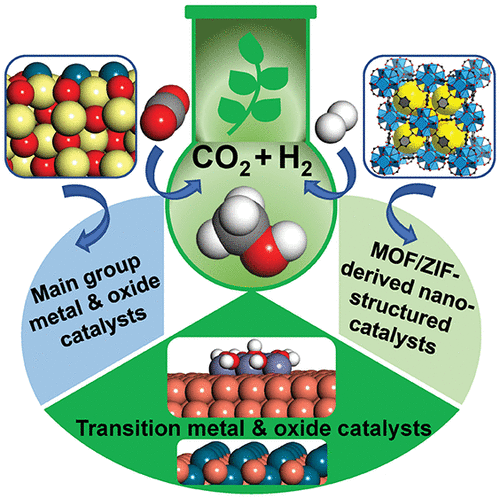当前位置:
X-MOL 学术
›
Chem. Rev.
›
论文详情
Our official English website, www.x-mol.net, welcomes your feedback! (Note: you will need to create a separate account there.)
Recent Advances in Carbon Dioxide Hydrogenation to Methanol via Heterogeneous Catalysis.
Chemical Reviews ( IF 62.1 ) Pub Date : 2020-02-12 , DOI: 10.1021/acs.chemrev.9b00723 Xiao Jiang 1 , Xiaowa Nie 2, 3 , Xinwen Guo 2 , Chunshan Song 2, 4 , Jingguang G Chen 3
Chemical Reviews ( IF 62.1 ) Pub Date : 2020-02-12 , DOI: 10.1021/acs.chemrev.9b00723 Xiao Jiang 1 , Xiaowa Nie 2, 3 , Xinwen Guo 2 , Chunshan Song 2, 4 , Jingguang G Chen 3
Affiliation

|
The utilization of fossil fuels has enabled an unprecedented era of prosperity and advancement of well-being for human society. However, the associated increase in anthropogenic carbon dioxide (CO2) emissions can negatively affect global temperatures and ocean acidity. Moreover, fossil fuels are a limited resource and their depletion will ultimately force one to seek alternative carbon sources to maintain a sustainable economy. Converting CO2 into value-added chemicals and fuels, using renewable energy, is one of the promising approaches in this regard. Major advances in energy-efficient CO2 conversion can potentially alleviate CO2 emissions, reduce the dependence on nonrenewable resources, and minimize the environmental impacts from the portions of fossil fuels displaced. Methanol (CH3OH) is an important chemical feedstock and can be used as a fuel for internal combustion engines and fuel cells, as well as a platform molecule for the production of chemicals and fuels. As one of the promising approaches, thermocatalytic CO2 hydrogenation to CH3OH via heterogeneous catalysis has attracted great attention in the past decades. Major progress has been made in the development of various catalysts including metals, metal oxides, and intermetallic compounds. In addition, efforts are also put forth to define catalyst structures in nanoscale by taking advantage of nanostructured materials, which enables the tuning of the catalyst composition and modulation of surface structures and potentially endows more promising catalytic performance in comparison to the bulk materials prepared by traditional methods. Despite these achievements, significant challenges still exist in developing robust catalysts with good catalytic performance and long-term stability. In this review, we will provide a comprehensive overview of the recent advances in this area, especially focusing on structure–activity relationship, as well as the importance of combining catalytic measurements, in situ characterization, and theoretical studies in understanding reaction mechanisms and identifying key descriptors for designing improved catalysts.
中文翻译:

通过非均相催化二氧化碳加氢制甲醇的最新进展。
化石燃料的利用为人类社会开创了前所未有的繁荣和福祉时代。但是,与之相关的人为二氧化碳(CO 2)排放量的增加可能会对全球温度和海洋酸度产生负面影响。此外,化石燃料是一种有限的资源,其枯竭最终将迫使人们寻求替代碳源以维持可持续的经济。使用可再生能源将CO 2转化为增值化学品和燃料是这方面的有前途的方法之一。节能型CO 2转化的重大进步可以缓解CO 2排放,减少了对不可再生资源的依赖,并最大程度地减少了被替代的化石燃料对环境的影响。甲醇(CH 3 OH)是重要的化学原料,可用作内燃机和燃料电池的燃料,以及用于生产化学药品和燃料的平台分子。作为有前途的方法之一,将CO 2热催化加氢成CH 3在过去的几十年中,通过多相催化的OH引起了极大的关注。在各种催化剂包括金属,金属氧化物和金属间化合物的开发方面已取得重大进展。另外,还努力通过利用纳米结构材料来在纳米级上定义催化剂结构,与传统方法制备的块状材料相比,该结构能够调节催化剂组成和调节表面结构,并可能赋予更广阔的催化性能。方法。尽管取得了这些成就,但是在开发具有良好催化性能和长期稳定性的坚固催化剂方面仍然存在重大挑战。在这篇评论中,我们将全面概述该领域的最新进展,
更新日期:2020-02-12
中文翻译:

通过非均相催化二氧化碳加氢制甲醇的最新进展。
化石燃料的利用为人类社会开创了前所未有的繁荣和福祉时代。但是,与之相关的人为二氧化碳(CO 2)排放量的增加可能会对全球温度和海洋酸度产生负面影响。此外,化石燃料是一种有限的资源,其枯竭最终将迫使人们寻求替代碳源以维持可持续的经济。使用可再生能源将CO 2转化为增值化学品和燃料是这方面的有前途的方法之一。节能型CO 2转化的重大进步可以缓解CO 2排放,减少了对不可再生资源的依赖,并最大程度地减少了被替代的化石燃料对环境的影响。甲醇(CH 3 OH)是重要的化学原料,可用作内燃机和燃料电池的燃料,以及用于生产化学药品和燃料的平台分子。作为有前途的方法之一,将CO 2热催化加氢成CH 3在过去的几十年中,通过多相催化的OH引起了极大的关注。在各种催化剂包括金属,金属氧化物和金属间化合物的开发方面已取得重大进展。另外,还努力通过利用纳米结构材料来在纳米级上定义催化剂结构,与传统方法制备的块状材料相比,该结构能够调节催化剂组成和调节表面结构,并可能赋予更广阔的催化性能。方法。尽管取得了这些成就,但是在开发具有良好催化性能和长期稳定性的坚固催化剂方面仍然存在重大挑战。在这篇评论中,我们将全面概述该领域的最新进展,



























 京公网安备 11010802027423号
京公网安备 11010802027423号